NURS6120: Clinical Practitioners and Technology Challenges Blog
VerifiedAdded on 2023/06/10
|8
|2581
|332
AI Summary
This blog post examines the challenges faced by clinical practitioners due to dynamic changes and the introduction of new technologies in healthcare, focusing on the issues arising from technological innovation in clinical practice. It highlights the concerns around trust, training, and the impact on patient safety, communities, and workplace management. The discussion covers the difficulties experienced by experienced practitioners in adopting new technologies, the potential negative effects on both patient and practitioner safety, and the importance of data privacy as mandated by acts like HIPAA. Strategies for acute and primary health care settings are proposed to mitigate these challenges, including continuous training, affordable technology implementation, and the recruitment of competent personnel. The blog concludes by emphasizing the need for education, resources, and support for advanced practice nurses and nurse practitioners to effectively navigate these technological advancements.
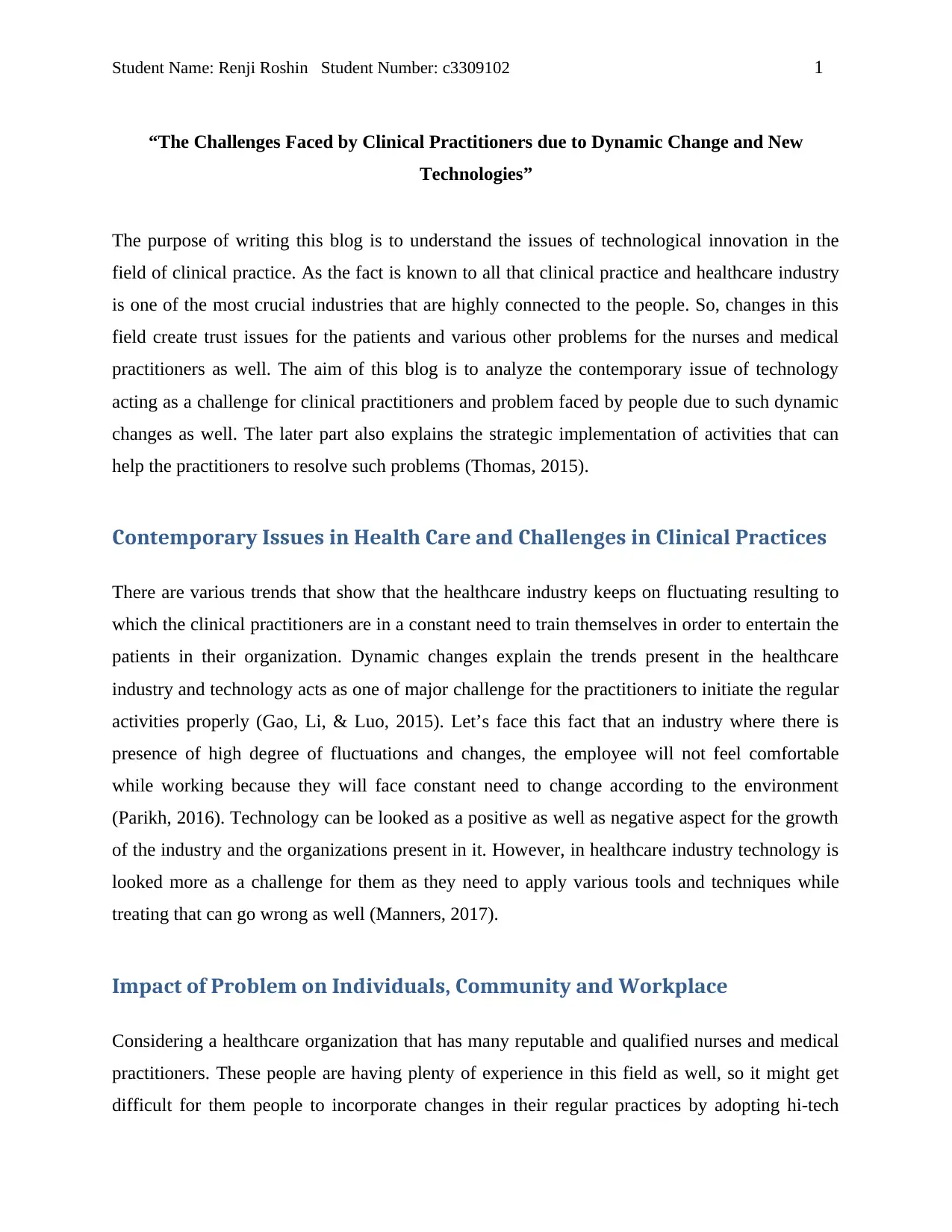
Student Name: Renji Roshin Student Number: c3309102 1
“The Challenges Faced by Clinical Practitioners due to Dynamic Change and New
Technologies”
The purpose of writing this blog is to understand the issues of technological innovation in the
field of clinical practice. As the fact is known to all that clinical practice and healthcare industry
is one of the most crucial industries that are highly connected to the people. So, changes in this
field create trust issues for the patients and various other problems for the nurses and medical
practitioners as well. The aim of this blog is to analyze the contemporary issue of technology
acting as a challenge for clinical practitioners and problem faced by people due to such dynamic
changes as well. The later part also explains the strategic implementation of activities that can
help the practitioners to resolve such problems (Thomas, 2015).
Contemporary Issues in Health Care and Challenges in Clinical Practices
There are various trends that show that the healthcare industry keeps on fluctuating resulting to
which the clinical practitioners are in a constant need to train themselves in order to entertain the
patients in their organization. Dynamic changes explain the trends present in the healthcare
industry and technology acts as one of major challenge for the practitioners to initiate the regular
activities properly (Gao, Li, & Luo, 2015). Let’s face this fact that an industry where there is
presence of high degree of fluctuations and changes, the employee will not feel comfortable
while working because they will face constant need to change according to the environment
(Parikh, 2016). Technology can be looked as a positive as well as negative aspect for the growth
of the industry and the organizations present in it. However, in healthcare industry technology is
looked more as a challenge for them as they need to apply various tools and techniques while
treating that can go wrong as well (Manners, 2017).
Impact of Problem on Individuals, Community and Workplace
Considering a healthcare organization that has many reputable and qualified nurses and medical
practitioners. These people are having plenty of experience in this field as well, so it might get
difficult for them people to incorporate changes in their regular practices by adopting hi-tech
“The Challenges Faced by Clinical Practitioners due to Dynamic Change and New
Technologies”
The purpose of writing this blog is to understand the issues of technological innovation in the
field of clinical practice. As the fact is known to all that clinical practice and healthcare industry
is one of the most crucial industries that are highly connected to the people. So, changes in this
field create trust issues for the patients and various other problems for the nurses and medical
practitioners as well. The aim of this blog is to analyze the contemporary issue of technology
acting as a challenge for clinical practitioners and problem faced by people due to such dynamic
changes as well. The later part also explains the strategic implementation of activities that can
help the practitioners to resolve such problems (Thomas, 2015).
Contemporary Issues in Health Care and Challenges in Clinical Practices
There are various trends that show that the healthcare industry keeps on fluctuating resulting to
which the clinical practitioners are in a constant need to train themselves in order to entertain the
patients in their organization. Dynamic changes explain the trends present in the healthcare
industry and technology acts as one of major challenge for the practitioners to initiate the regular
activities properly (Gao, Li, & Luo, 2015). Let’s face this fact that an industry where there is
presence of high degree of fluctuations and changes, the employee will not feel comfortable
while working because they will face constant need to change according to the environment
(Parikh, 2016). Technology can be looked as a positive as well as negative aspect for the growth
of the industry and the organizations present in it. However, in healthcare industry technology is
looked more as a challenge for them as they need to apply various tools and techniques while
treating that can go wrong as well (Manners, 2017).
Impact of Problem on Individuals, Community and Workplace
Considering a healthcare organization that has many reputable and qualified nurses and medical
practitioners. These people are having plenty of experience in this field as well, so it might get
difficult for them people to incorporate changes in their regular practices by adopting hi-tech
Paraphrase This Document
Need a fresh take? Get an instant paraphrase of this document with our AI Paraphraser
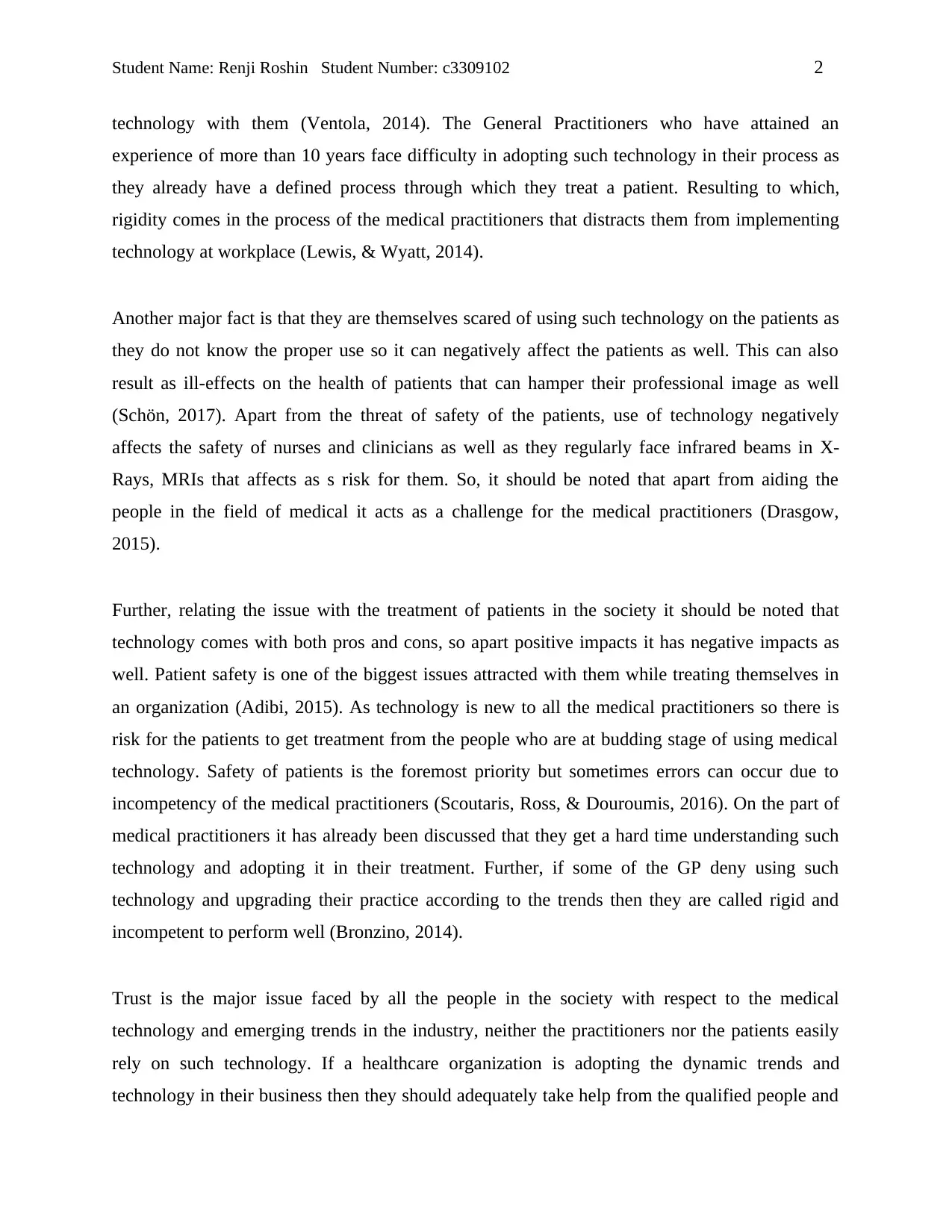
Student Name: Renji Roshin Student Number: c3309102 2
technology with them (Ventola, 2014). The General Practitioners who have attained an
experience of more than 10 years face difficulty in adopting such technology in their process as
they already have a defined process through which they treat a patient. Resulting to which,
rigidity comes in the process of the medical practitioners that distracts them from implementing
technology at workplace (Lewis, & Wyatt, 2014).
Another major fact is that they are themselves scared of using such technology on the patients as
they do not know the proper use so it can negatively affect the patients as well. This can also
result as ill-effects on the health of patients that can hamper their professional image as well
(Schön, 2017). Apart from the threat of safety of the patients, use of technology negatively
affects the safety of nurses and clinicians as well as they regularly face infrared beams in X-
Rays, MRIs that affects as s risk for them. So, it should be noted that apart from aiding the
people in the field of medical it acts as a challenge for the medical practitioners (Drasgow,
2015).
Further, relating the issue with the treatment of patients in the society it should be noted that
technology comes with both pros and cons, so apart positive impacts it has negative impacts as
well. Patient safety is one of the biggest issues attracted with them while treating themselves in
an organization (Adibi, 2015). As technology is new to all the medical practitioners so there is
risk for the patients to get treatment from the people who are at budding stage of using medical
technology. Safety of patients is the foremost priority but sometimes errors can occur due to
incompetency of the medical practitioners (Scoutaris, Ross, & Douroumis, 2016). On the part of
medical practitioners it has already been discussed that they get a hard time understanding such
technology and adopting it in their treatment. Further, if some of the GP deny using such
technology and upgrading their practice according to the trends then they are called rigid and
incompetent to perform well (Bronzino, 2014).
Trust is the major issue faced by all the people in the society with respect to the medical
technology and emerging trends in the industry, neither the practitioners nor the patients easily
rely on such technology. If a healthcare organization is adopting the dynamic trends and
technology in their business then they should adequately take help from the qualified people and
technology with them (Ventola, 2014). The General Practitioners who have attained an
experience of more than 10 years face difficulty in adopting such technology in their process as
they already have a defined process through which they treat a patient. Resulting to which,
rigidity comes in the process of the medical practitioners that distracts them from implementing
technology at workplace (Lewis, & Wyatt, 2014).
Another major fact is that they are themselves scared of using such technology on the patients as
they do not know the proper use so it can negatively affect the patients as well. This can also
result as ill-effects on the health of patients that can hamper their professional image as well
(Schön, 2017). Apart from the threat of safety of the patients, use of technology negatively
affects the safety of nurses and clinicians as well as they regularly face infrared beams in X-
Rays, MRIs that affects as s risk for them. So, it should be noted that apart from aiding the
people in the field of medical it acts as a challenge for the medical practitioners (Drasgow,
2015).
Further, relating the issue with the treatment of patients in the society it should be noted that
technology comes with both pros and cons, so apart positive impacts it has negative impacts as
well. Patient safety is one of the biggest issues attracted with them while treating themselves in
an organization (Adibi, 2015). As technology is new to all the medical practitioners so there is
risk for the patients to get treatment from the people who are at budding stage of using medical
technology. Safety of patients is the foremost priority but sometimes errors can occur due to
incompetency of the medical practitioners (Scoutaris, Ross, & Douroumis, 2016). On the part of
medical practitioners it has already been discussed that they get a hard time understanding such
technology and adopting it in their treatment. Further, if some of the GP deny using such
technology and upgrading their practice according to the trends then they are called rigid and
incompetent to perform well (Bronzino, 2014).
Trust is the major issue faced by all the people in the society with respect to the medical
technology and emerging trends in the industry, neither the practitioners nor the patients easily
rely on such technology. If a healthcare organization is adopting the dynamic trends and
technology in their business then they should adequately take help from the qualified people and
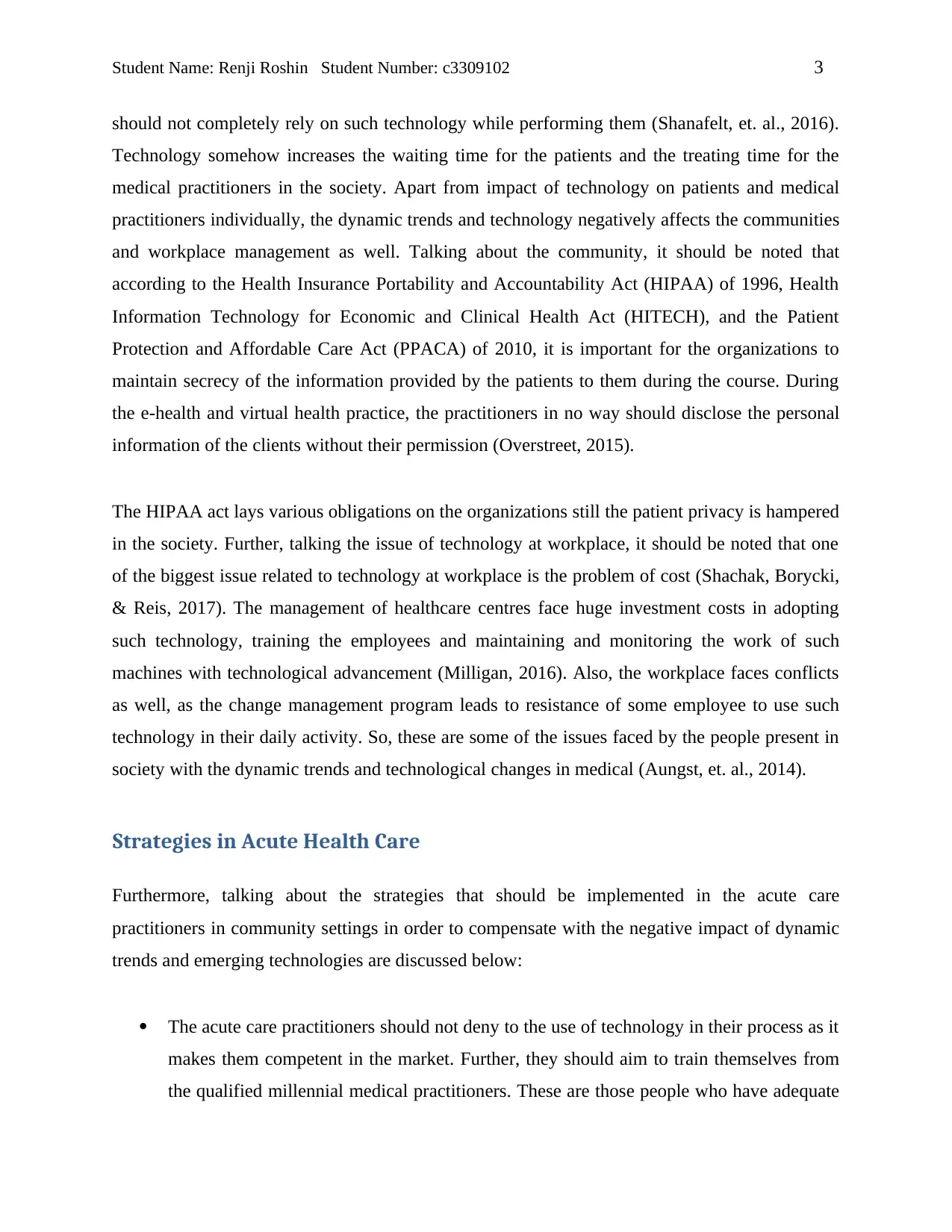
Student Name: Renji Roshin Student Number: c3309102 3
should not completely rely on such technology while performing them (Shanafelt, et. al., 2016).
Technology somehow increases the waiting time for the patients and the treating time for the
medical practitioners in the society. Apart from impact of technology on patients and medical
practitioners individually, the dynamic trends and technology negatively affects the communities
and workplace management as well. Talking about the community, it should be noted that
according to the Health Insurance Portability and Accountability Act (HIPAA) of 1996, Health
Information Technology for Economic and Clinical Health Act (HITECH), and the Patient
Protection and Affordable Care Act (PPACA) of 2010, it is important for the organizations to
maintain secrecy of the information provided by the patients to them during the course. During
the e-health and virtual health practice, the practitioners in no way should disclose the personal
information of the clients without their permission (Overstreet, 2015).
The HIPAA act lays various obligations on the organizations still the patient privacy is hampered
in the society. Further, talking the issue of technology at workplace, it should be noted that one
of the biggest issue related to technology at workplace is the problem of cost (Shachak, Borycki,
& Reis, 2017). The management of healthcare centres face huge investment costs in adopting
such technology, training the employees and maintaining and monitoring the work of such
machines with technological advancement (Milligan, 2016). Also, the workplace faces conflicts
as well, as the change management program leads to resistance of some employee to use such
technology in their daily activity. So, these are some of the issues faced by the people present in
society with the dynamic trends and technological changes in medical (Aungst, et. al., 2014).
Strategies in Acute Health Care
Furthermore, talking about the strategies that should be implemented in the acute care
practitioners in community settings in order to compensate with the negative impact of dynamic
trends and emerging technologies are discussed below:
The acute care practitioners should not deny to the use of technology in their process as it
makes them competent in the market. Further, they should aim to train themselves from
the qualified millennial medical practitioners. These are those people who have adequate
should not completely rely on such technology while performing them (Shanafelt, et. al., 2016).
Technology somehow increases the waiting time for the patients and the treating time for the
medical practitioners in the society. Apart from impact of technology on patients and medical
practitioners individually, the dynamic trends and technology negatively affects the communities
and workplace management as well. Talking about the community, it should be noted that
according to the Health Insurance Portability and Accountability Act (HIPAA) of 1996, Health
Information Technology for Economic and Clinical Health Act (HITECH), and the Patient
Protection and Affordable Care Act (PPACA) of 2010, it is important for the organizations to
maintain secrecy of the information provided by the patients to them during the course. During
the e-health and virtual health practice, the practitioners in no way should disclose the personal
information of the clients without their permission (Overstreet, 2015).
The HIPAA act lays various obligations on the organizations still the patient privacy is hampered
in the society. Further, talking the issue of technology at workplace, it should be noted that one
of the biggest issue related to technology at workplace is the problem of cost (Shachak, Borycki,
& Reis, 2017). The management of healthcare centres face huge investment costs in adopting
such technology, training the employees and maintaining and monitoring the work of such
machines with technological advancement (Milligan, 2016). Also, the workplace faces conflicts
as well, as the change management program leads to resistance of some employee to use such
technology in their daily activity. So, these are some of the issues faced by the people present in
society with the dynamic trends and technological changes in medical (Aungst, et. al., 2014).
Strategies in Acute Health Care
Furthermore, talking about the strategies that should be implemented in the acute care
practitioners in community settings in order to compensate with the negative impact of dynamic
trends and emerging technologies are discussed below:
The acute care practitioners should not deny to the use of technology in their process as it
makes them competent in the market. Further, they should aim to train themselves from
the qualified millennial medical practitioners. These are those people who have adequate
⊘ This is a preview!⊘
Do you want full access?
Subscribe today to unlock all pages.

Trusted by 1+ million students worldwide
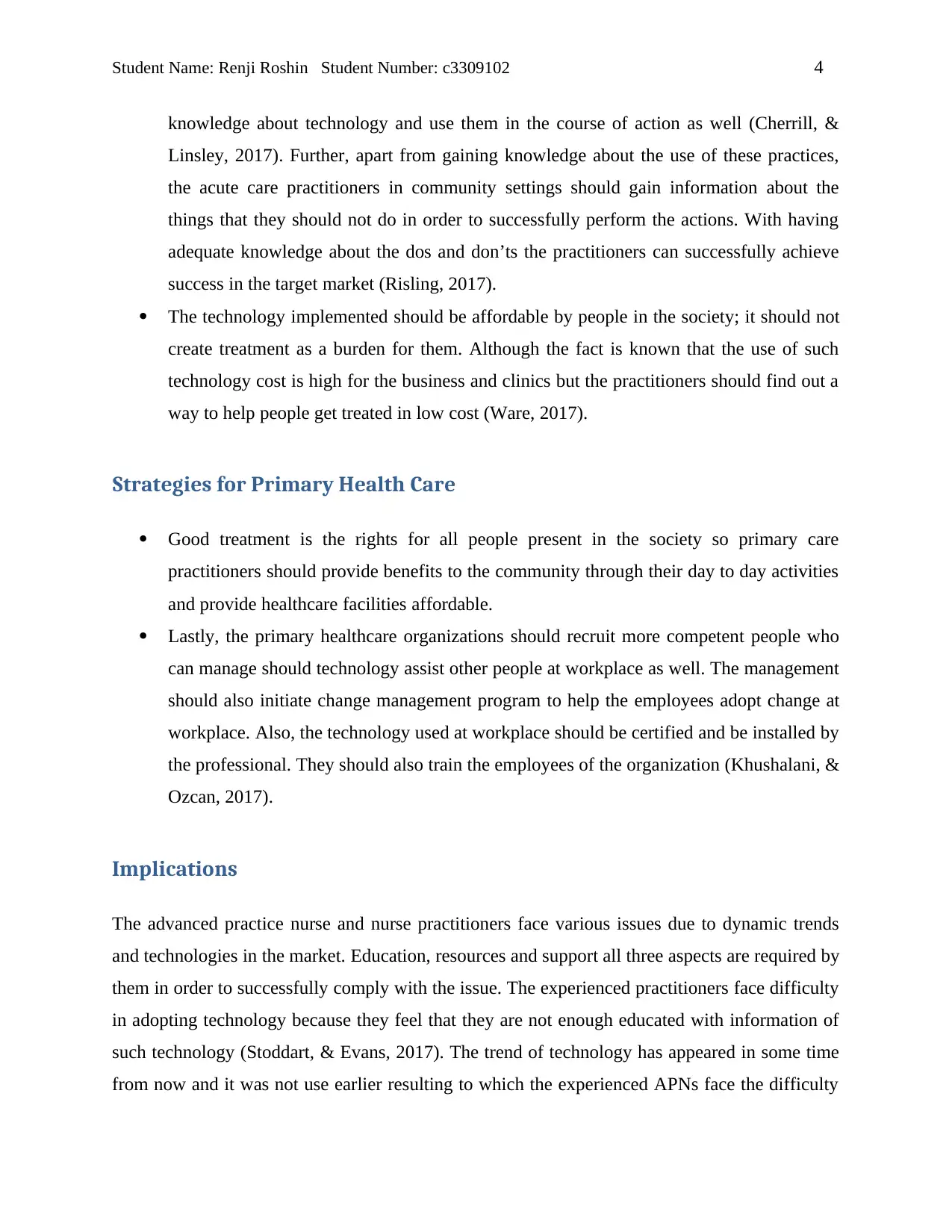
Student Name: Renji Roshin Student Number: c3309102 4
knowledge about technology and use them in the course of action as well (Cherrill, &
Linsley, 2017). Further, apart from gaining knowledge about the use of these practices,
the acute care practitioners in community settings should gain information about the
things that they should not do in order to successfully perform the actions. With having
adequate knowledge about the dos and don’ts the practitioners can successfully achieve
success in the target market (Risling, 2017).
The technology implemented should be affordable by people in the society; it should not
create treatment as a burden for them. Although the fact is known that the use of such
technology cost is high for the business and clinics but the practitioners should find out a
way to help people get treated in low cost (Ware, 2017).
Strategies for Primary Health Care
Good treatment is the rights for all people present in the society so primary care
practitioners should provide benefits to the community through their day to day activities
and provide healthcare facilities affordable.
Lastly, the primary healthcare organizations should recruit more competent people who
can manage should technology assist other people at workplace as well. The management
should also initiate change management program to help the employees adopt change at
workplace. Also, the technology used at workplace should be certified and be installed by
the professional. They should also train the employees of the organization (Khushalani, &
Ozcan, 2017).
Implications
The advanced practice nurse and nurse practitioners face various issues due to dynamic trends
and technologies in the market. Education, resources and support all three aspects are required by
them in order to successfully comply with the issue. The experienced practitioners face difficulty
in adopting technology because they feel that they are not enough educated with information of
such technology (Stoddart, & Evans, 2017). The trend of technology has appeared in some time
from now and it was not use earlier resulting to which the experienced APNs face the difficulty
knowledge about technology and use them in the course of action as well (Cherrill, &
Linsley, 2017). Further, apart from gaining knowledge about the use of these practices,
the acute care practitioners in community settings should gain information about the
things that they should not do in order to successfully perform the actions. With having
adequate knowledge about the dos and don’ts the practitioners can successfully achieve
success in the target market (Risling, 2017).
The technology implemented should be affordable by people in the society; it should not
create treatment as a burden for them. Although the fact is known that the use of such
technology cost is high for the business and clinics but the practitioners should find out a
way to help people get treated in low cost (Ware, 2017).
Strategies for Primary Health Care
Good treatment is the rights for all people present in the society so primary care
practitioners should provide benefits to the community through their day to day activities
and provide healthcare facilities affordable.
Lastly, the primary healthcare organizations should recruit more competent people who
can manage should technology assist other people at workplace as well. The management
should also initiate change management program to help the employees adopt change at
workplace. Also, the technology used at workplace should be certified and be installed by
the professional. They should also train the employees of the organization (Khushalani, &
Ozcan, 2017).
Implications
The advanced practice nurse and nurse practitioners face various issues due to dynamic trends
and technologies in the market. Education, resources and support all three aspects are required by
them in order to successfully comply with the issue. The experienced practitioners face difficulty
in adopting technology because they feel that they are not enough educated with information of
such technology (Stoddart, & Evans, 2017). The trend of technology has appeared in some time
from now and it was not use earlier resulting to which the experienced APNs face the difficulty
Paraphrase This Document
Need a fresh take? Get an instant paraphrase of this document with our AI Paraphraser
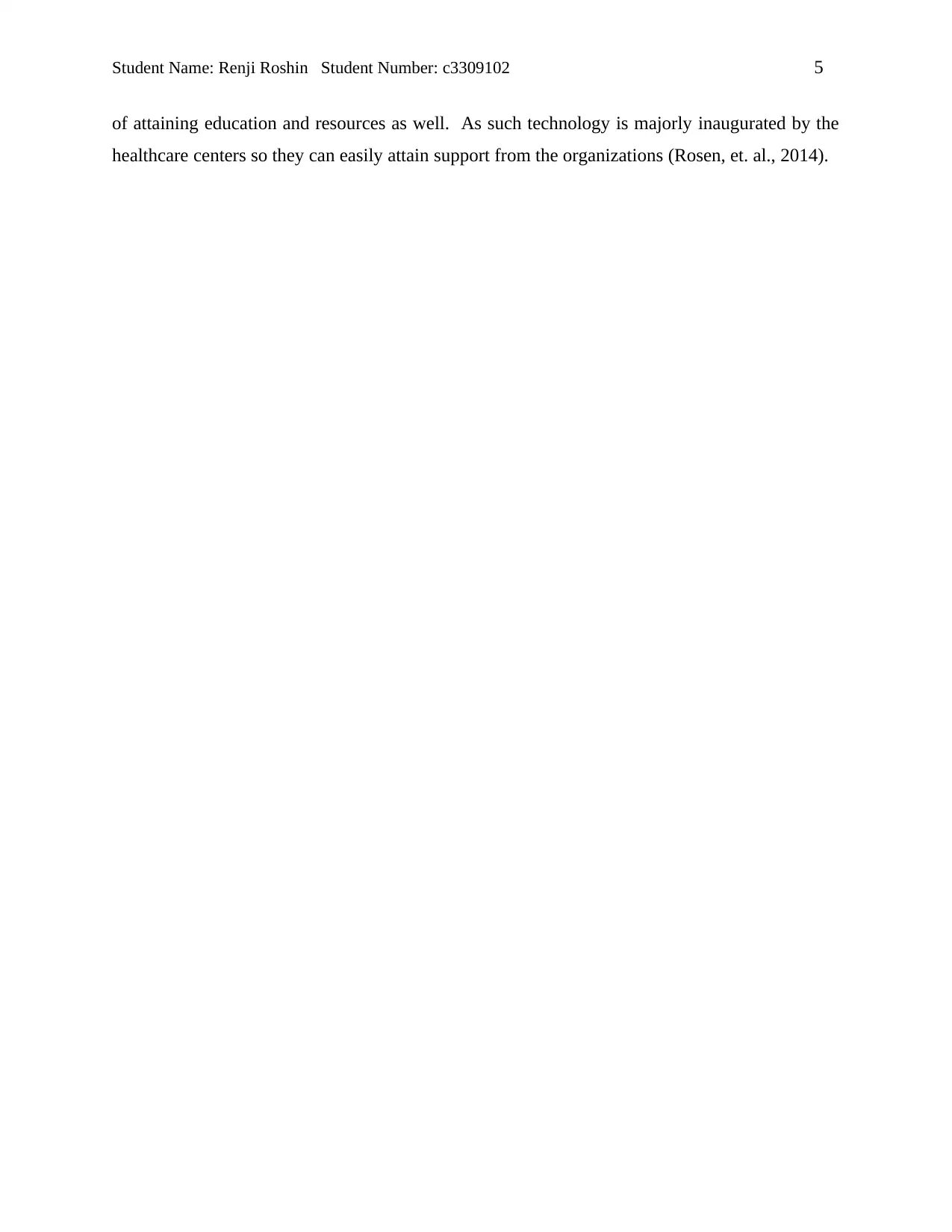
Student Name: Renji Roshin Student Number: c3309102 5
of attaining education and resources as well. As such technology is majorly inaugurated by the
healthcare centers so they can easily attain support from the organizations (Rosen, et. al., 2014).
of attaining education and resources as well. As such technology is majorly inaugurated by the
healthcare centers so they can easily attain support from the organizations (Rosen, et. al., 2014).
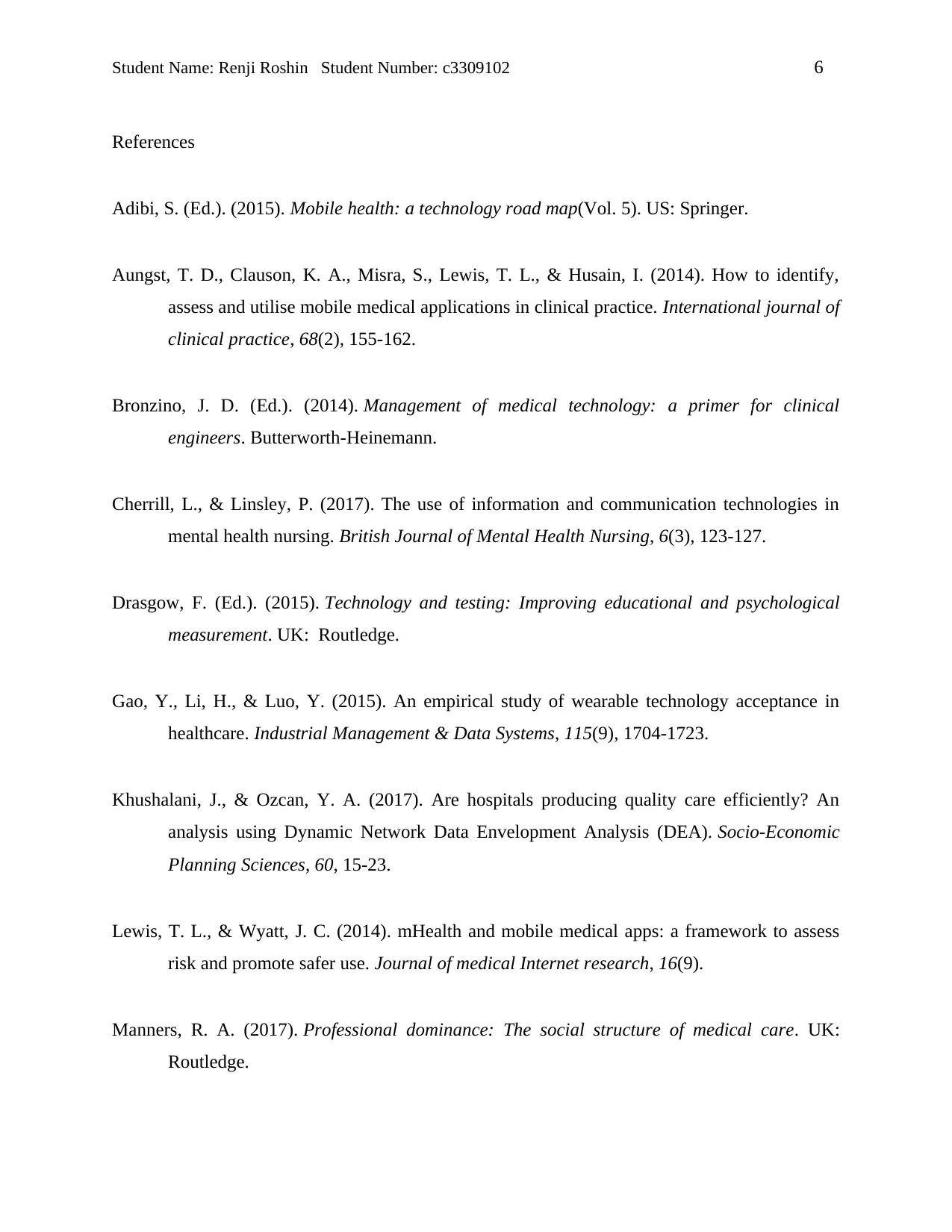
Student Name: Renji Roshin Student Number: c3309102 6
References
Adibi, S. (Ed.). (2015). Mobile health: a technology road map(Vol. 5). US: Springer.
Aungst, T. D., Clauson, K. A., Misra, S., Lewis, T. L., & Husain, I. (2014). How to identify,
assess and utilise mobile medical applications in clinical practice. International journal of
clinical practice, 68(2), 155-162.
Bronzino, J. D. (Ed.). (2014). Management of medical technology: a primer for clinical
engineers. Butterworth-Heinemann.
Cherrill, L., & Linsley, P. (2017). The use of information and communication technologies in
mental health nursing. British Journal of Mental Health Nursing, 6(3), 123-127.
Drasgow, F. (Ed.). (2015). Technology and testing: Improving educational and psychological
measurement. UK: Routledge.
Gao, Y., Li, H., & Luo, Y. (2015). An empirical study of wearable technology acceptance in
healthcare. Industrial Management & Data Systems, 115(9), 1704-1723.
Khushalani, J., & Ozcan, Y. A. (2017). Are hospitals producing quality care efficiently? An
analysis using Dynamic Network Data Envelopment Analysis (DEA). Socio-Economic
Planning Sciences, 60, 15-23.
Lewis, T. L., & Wyatt, J. C. (2014). mHealth and mobile medical apps: a framework to assess
risk and promote safer use. Journal of medical Internet research, 16(9).
Manners, R. A. (2017). Professional dominance: The social structure of medical care. UK:
Routledge.
References
Adibi, S. (Ed.). (2015). Mobile health: a technology road map(Vol. 5). US: Springer.
Aungst, T. D., Clauson, K. A., Misra, S., Lewis, T. L., & Husain, I. (2014). How to identify,
assess and utilise mobile medical applications in clinical practice. International journal of
clinical practice, 68(2), 155-162.
Bronzino, J. D. (Ed.). (2014). Management of medical technology: a primer for clinical
engineers. Butterworth-Heinemann.
Cherrill, L., & Linsley, P. (2017). The use of information and communication technologies in
mental health nursing. British Journal of Mental Health Nursing, 6(3), 123-127.
Drasgow, F. (Ed.). (2015). Technology and testing: Improving educational and psychological
measurement. UK: Routledge.
Gao, Y., Li, H., & Luo, Y. (2015). An empirical study of wearable technology acceptance in
healthcare. Industrial Management & Data Systems, 115(9), 1704-1723.
Khushalani, J., & Ozcan, Y. A. (2017). Are hospitals producing quality care efficiently? An
analysis using Dynamic Network Data Envelopment Analysis (DEA). Socio-Economic
Planning Sciences, 60, 15-23.
Lewis, T. L., & Wyatt, J. C. (2014). mHealth and mobile medical apps: a framework to assess
risk and promote safer use. Journal of medical Internet research, 16(9).
Manners, R. A. (2017). Professional dominance: The social structure of medical care. UK:
Routledge.
⊘ This is a preview!⊘
Do you want full access?
Subscribe today to unlock all pages.

Trusted by 1+ million students worldwide
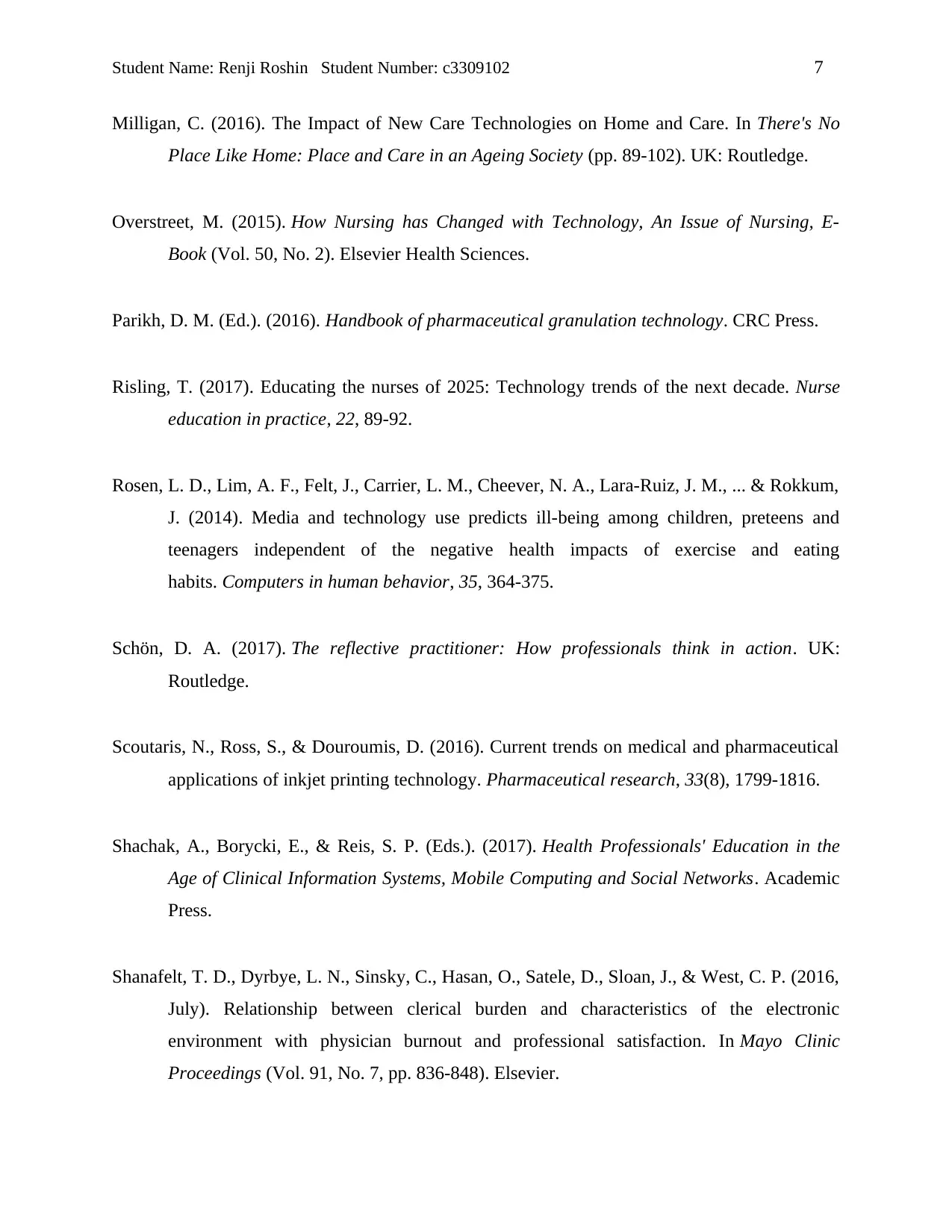
Student Name: Renji Roshin Student Number: c3309102 7
Milligan, C. (2016). The Impact of New Care Technologies on Home and Care. In There's No
Place Like Home: Place and Care in an Ageing Society (pp. 89-102). UK: Routledge.
Overstreet, M. (2015). How Nursing has Changed with Technology, An Issue of Nursing, E-
Book (Vol. 50, No. 2). Elsevier Health Sciences.
Parikh, D. M. (Ed.). (2016). Handbook of pharmaceutical granulation technology. CRC Press.
Risling, T. (2017). Educating the nurses of 2025: Technology trends of the next decade. Nurse
education in practice, 22, 89-92.
Rosen, L. D., Lim, A. F., Felt, J., Carrier, L. M., Cheever, N. A., Lara-Ruiz, J. M., ... & Rokkum,
J. (2014). Media and technology use predicts ill-being among children, preteens and
teenagers independent of the negative health impacts of exercise and eating
habits. Computers in human behavior, 35, 364-375.
Schön, D. A. (2017). The reflective practitioner: How professionals think in action. UK:
Routledge.
Scoutaris, N., Ross, S., & Douroumis, D. (2016). Current trends on medical and pharmaceutical
applications of inkjet printing technology. Pharmaceutical research, 33(8), 1799-1816.
Shachak, A., Borycki, E., & Reis, S. P. (Eds.). (2017). Health Professionals' Education in the
Age of Clinical Information Systems, Mobile Computing and Social Networks. Academic
Press.
Shanafelt, T. D., Dyrbye, L. N., Sinsky, C., Hasan, O., Satele, D., Sloan, J., & West, C. P. (2016,
July). Relationship between clerical burden and characteristics of the electronic
environment with physician burnout and professional satisfaction. In Mayo Clinic
Proceedings (Vol. 91, No. 7, pp. 836-848). Elsevier.
Milligan, C. (2016). The Impact of New Care Technologies on Home and Care. In There's No
Place Like Home: Place and Care in an Ageing Society (pp. 89-102). UK: Routledge.
Overstreet, M. (2015). How Nursing has Changed with Technology, An Issue of Nursing, E-
Book (Vol. 50, No. 2). Elsevier Health Sciences.
Parikh, D. M. (Ed.). (2016). Handbook of pharmaceutical granulation technology. CRC Press.
Risling, T. (2017). Educating the nurses of 2025: Technology trends of the next decade. Nurse
education in practice, 22, 89-92.
Rosen, L. D., Lim, A. F., Felt, J., Carrier, L. M., Cheever, N. A., Lara-Ruiz, J. M., ... & Rokkum,
J. (2014). Media and technology use predicts ill-being among children, preteens and
teenagers independent of the negative health impacts of exercise and eating
habits. Computers in human behavior, 35, 364-375.
Schön, D. A. (2017). The reflective practitioner: How professionals think in action. UK:
Routledge.
Scoutaris, N., Ross, S., & Douroumis, D. (2016). Current trends on medical and pharmaceutical
applications of inkjet printing technology. Pharmaceutical research, 33(8), 1799-1816.
Shachak, A., Borycki, E., & Reis, S. P. (Eds.). (2017). Health Professionals' Education in the
Age of Clinical Information Systems, Mobile Computing and Social Networks. Academic
Press.
Shanafelt, T. D., Dyrbye, L. N., Sinsky, C., Hasan, O., Satele, D., Sloan, J., & West, C. P. (2016,
July). Relationship between clerical burden and characteristics of the electronic
environment with physician burnout and professional satisfaction. In Mayo Clinic
Proceedings (Vol. 91, No. 7, pp. 836-848). Elsevier.
Paraphrase This Document
Need a fresh take? Get an instant paraphrase of this document with our AI Paraphraser
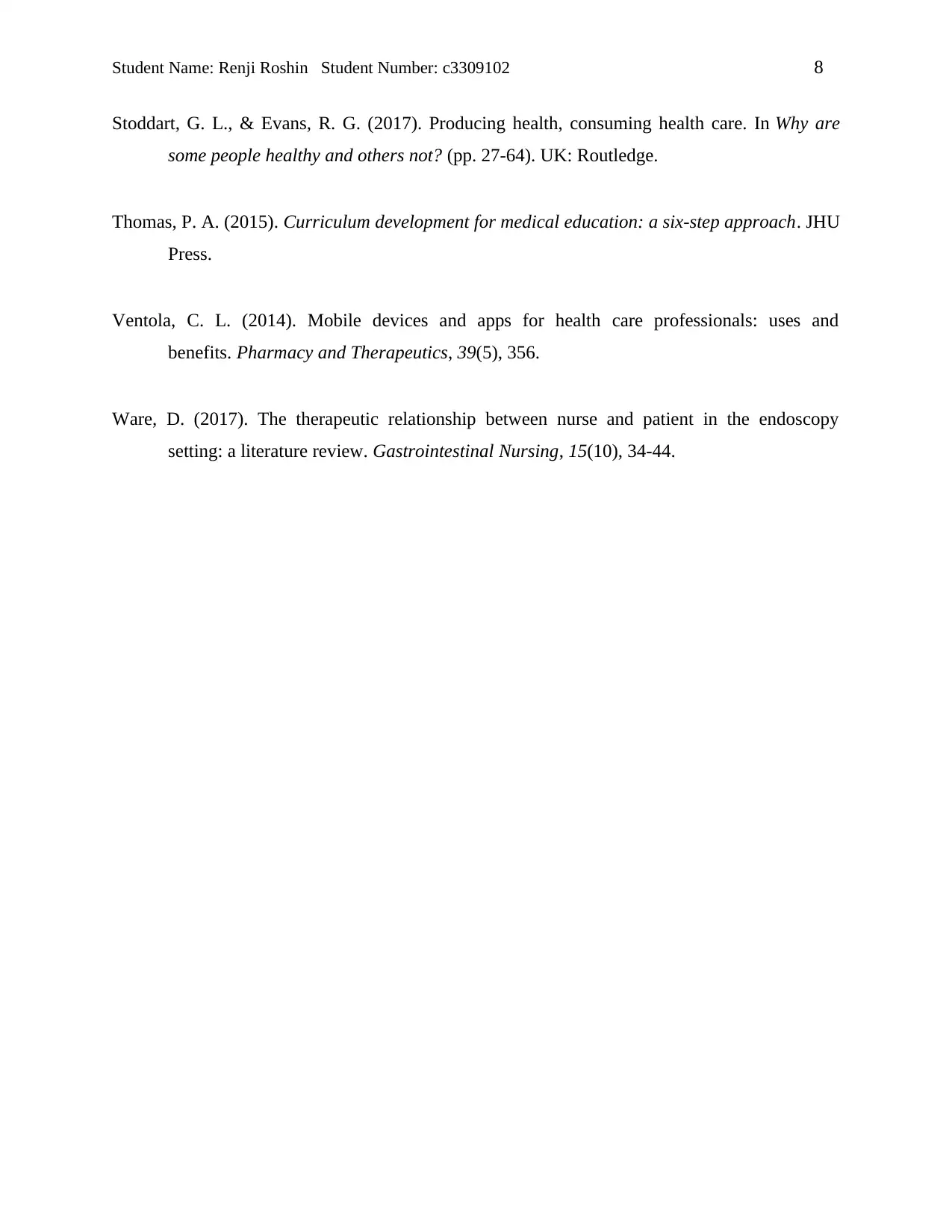
Student Name: Renji Roshin Student Number: c3309102 8
Stoddart, G. L., & Evans, R. G. (2017). Producing health, consuming health care. In Why are
some people healthy and others not? (pp. 27-64). UK: Routledge.
Thomas, P. A. (2015). Curriculum development for medical education: a six-step approach. JHU
Press.
Ventola, C. L. (2014). Mobile devices and apps for health care professionals: uses and
benefits. Pharmacy and Therapeutics, 39(5), 356.
Ware, D. (2017). The therapeutic relationship between nurse and patient in the endoscopy
setting: a literature review. Gastrointestinal Nursing, 15(10), 34-44.
Stoddart, G. L., & Evans, R. G. (2017). Producing health, consuming health care. In Why are
some people healthy and others not? (pp. 27-64). UK: Routledge.
Thomas, P. A. (2015). Curriculum development for medical education: a six-step approach. JHU
Press.
Ventola, C. L. (2014). Mobile devices and apps for health care professionals: uses and
benefits. Pharmacy and Therapeutics, 39(5), 356.
Ware, D. (2017). The therapeutic relationship between nurse and patient in the endoscopy
setting: a literature review. Gastrointestinal Nursing, 15(10), 34-44.
1 out of 8
Related Documents
Your All-in-One AI-Powered Toolkit for Academic Success.
+13062052269
info@desklib.com
Available 24*7 on WhatsApp / Email
![[object Object]](/_next/static/media/star-bottom.7253800d.svg)
Unlock your academic potential
Copyright © 2020–2025 A2Z Services. All Rights Reserved. Developed and managed by ZUCOL.





